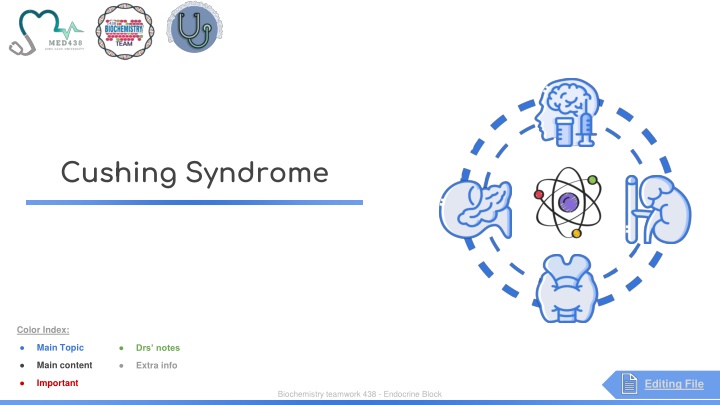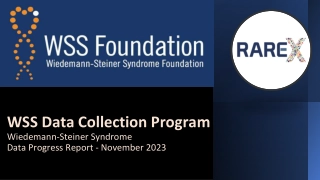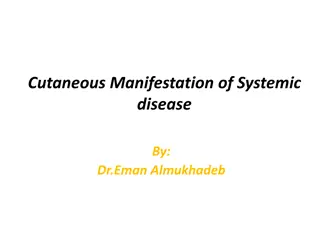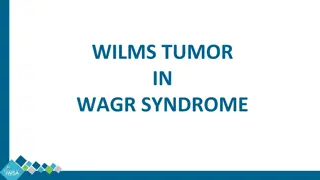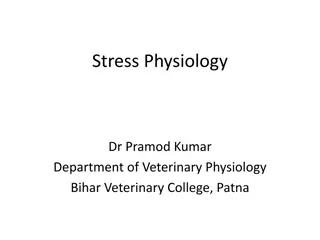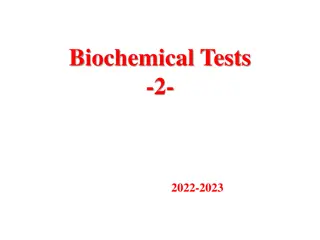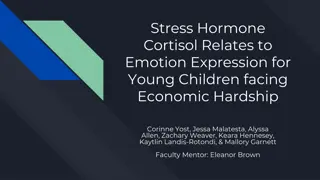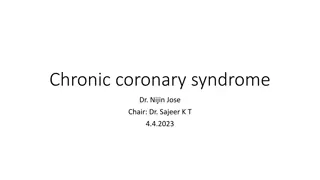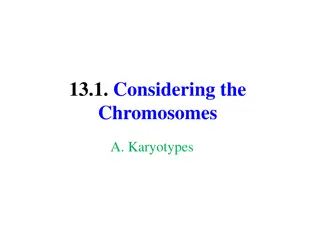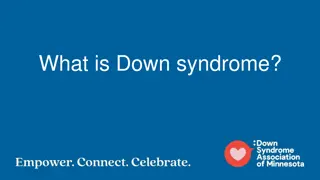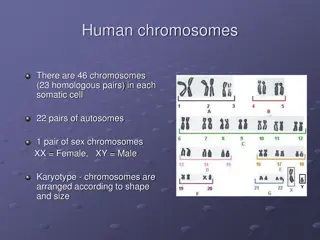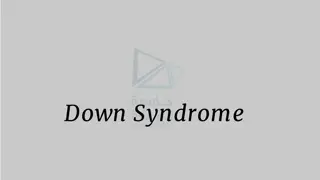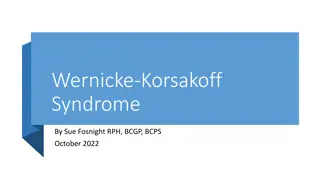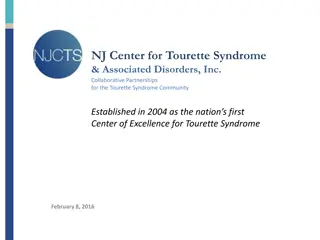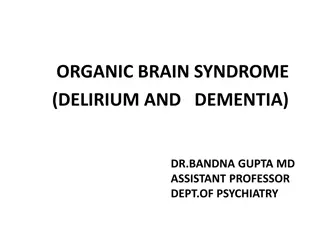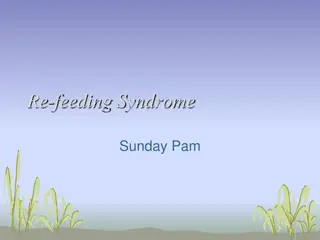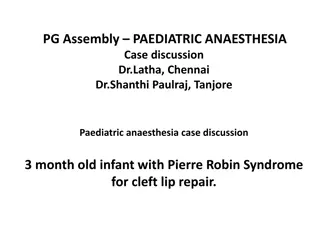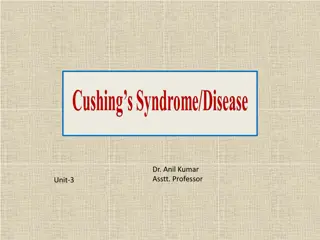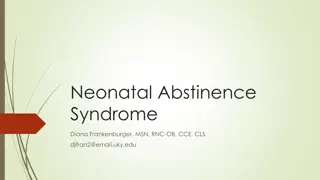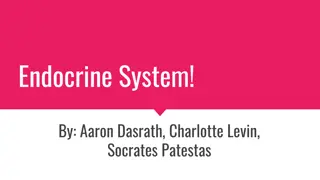Cortisol and Cushing's Syndrome: Biochemical Insights
This content delves into the physiological and biochemical aspects of cortisol, diagnostic algorithms for Cushing's syndrome, and the interpretation of laboratory and radiological investigations for diagnosis. Explore the adrenal gland's anatomical features, the HPA axis, and glucocorticoid functions impacting metabolism. Gain knowledge on the role of cortisol in glucose regulation, protein metabolism, and lipid breakdown. Discover the intricate relationship between cortisol and hormonal balance in the body.
Download Presentation

Please find below an Image/Link to download the presentation.
The content on the website is provided AS IS for your information and personal use only. It may not be sold, licensed, or shared on other websites without obtaining consent from the author.If you encounter any issues during the download, it is possible that the publisher has removed the file from their server.
You are allowed to download the files provided on this website for personal or commercial use, subject to the condition that they are used lawfully. All files are the property of their respective owners.
The content on the website is provided AS IS for your information and personal use only. It may not be sold, licensed, or shared on other websites without obtaining consent from the author.
E N D
Presentation Transcript
Cushing Syndrome Color Index: Main Topic Drs notes Main content Extra info Editing File Important Biochemistry teamwork 438 - Endocrine Block
Objectives: To identify physiological and biochemical characteristics of cortisol To understand the diagnostic algorithm for cushing s syndrome To understand the interpretation of laboratory and radiological investigation for diagnosis of cushing s syndrome 2 *best show ever*
Adrenal Gland Anatomically the gland is situated on the anterosuperior aspect of the kidney Zona Glomerulsoa (outermost zone) Aldosterone (the principal mineralocorticoid) Adrenal Gland Zona Fasciculata Glucocorticoids, mainly cortisol (95%) Based on cell type and function Adrenal cortex (Histology) The Medulla and the Cortex differ in their embryological origin Zona Reticularis Sex hormones Adrenal medulla 3
Hypothalamic Pituitary-Adrenal (HPA) Axis The CRH stimulate the anterior pituitary gland to secrete ACTH The hypothalamus secrete corticotropin releasing hormone (CRH) Release of glucocorticoids (Cortisol) ACTH acts on the Zona Fasciculata Steroid Hormone Synthesis Cholesterol (27C) Cholesterol Desmolase Pregnenolone (21C) 3- -Hydroxysteroid dehydrogenase (3 -HSD) Progesteron (21C) 17- -Hydroxylase 11-Deoxycorticosterone (21C) 21- -Hydoxylase 17- -Hydroxyprogesterone (21C) 11-Deoxycortisol (21C) Androstenedione (19C) 11- -Hydroxylase Peripheral tissues Corticosterone Testosterone (19C) Cortisol (21C) Aldosterone (21C) Estradiol (18C) Dr s note: It s is important to know the number of C and the precursor in particular
Glucocorticoid Functions Glucocorticoids have widespread metabolic effects on carbohydrates, fats and protein metabolism Upon binding to its target, CORTISOL enhances metabolism in several ways: In the liver it s insulin antagonist1and has weak mineralocorticoid action: 1. Gluconeogenesis2 production of glucose from newly-released amino acids and lipids 2. Amino acid uptake and degradation 3. Ketogenesis In liver In muscles Cortisol proteolysis and amino acids release In adipose tissue 3 Cortisol lipolysis through breakdown of fat Conserving glucose Conserve glucose by inhibiting its uptake into muscle and fat cells. 1-it will lower the level of insulin and increase glucose 2- The amino acid for gluconeogenesis are provided from the muscles and adipose tissue 3-The adipose tissue provide fats for both gluconeogenesis and ketogenesis 5
Regulation of ACTH and Cortisol Secretion ACTH release from the anterior pituitary is stimulated by hypothalamic secretion of CRH CRH ACTH [cortisol] [Cortisol] or synthetic steroid suppress CRH and ACTH secretion The diurnal rhythm of serum cortisol Highest cortisol level in the morning (8-9 AM) Lowest cortisol level in the late afternoon and evening (8-9 PM) Negative feedback j (e.g. major surgery, emotional stress) stress CRH & ACTH Cortisol Stress The diurnal rhythm of cortisol secretion the area between the curves represents values that lie within the reference range Plasma Cortisol Binding Globulin (CBG) In the circulation, glucocorticoids are mainly protein-bound (about 90%), chiefly to CBG In pregnancy and with estrogen treatment (e.g. oral contraceptives) In hypoproteinemic states (e.g. nephrotic syndrome) The biologically active fraction of cortisol in plasma is the free(unbound) component1 6 1- For investigation we look for the free form (The higher the level the higher the proteolysis)
Cortisol and ACTH Measurements Serum Cortisol1and plasma (ACTH): Urinary cortisol excretion: Cortisol is removed from plasma by the liver metabolically inactive compound excreted in urine mainly as conjugated metabolite (e.g. glucuronide) Sample must be collected (without venous stasis) between 8a.m and 9a.m. and between 10p.m. and 12a.m. because of the diurnal rhythm Temporary in these hormones may be observed as a response to emotional stress A small amount of cortisol is excreted unchanged in the urine (UFC)2 In normal individual: UFC is < 250 nmol/24 h Causes of Elevated Serum Cortisol Increased cortisol secretion Increased CBG Cushing s syndrome Exercise Stress, anxiety and depression Obesity Alcohol abuse Chronic renal failure Congenital Estrogen therapy Pregnancy 7 1-Plasma cortisol not used ALONE because there might be interference which can lead to false positive or false negative results 2- urinary free cortisol
Signs and Symptoms of Cushing's Syndrome Libido, amenorrhea and infertility Excess cortisol may also affect other endocrine system Helpful video for Cushing Patients frequently suffers various psychological disturbances ranging from euphoria to frank psychosis Atrophy of the skin and mucous membrane Symptoms Purple stria on the trunk and legs Weight gain and central obesity Proximal muscle weakness Moon face Buffalo s hump Hirsutism Signs Hypertension Protein metabolism (due to aldosterone like effect) Hyperglycaemia or diabetes due to insulin resistance Hypokalemic alkalosis Loss of diurnal rhythm of cortisol and ACTH Impaired immunity
Investigations of Suspected Adrenocortical Hyperfunction A. Screening and confirmatory tests To assess the clinical diagnosis of adrenocortical hyperfunction B. Test to determine the cause: to ascertain: 1) the site of the pathologic lesion 2) the nature of the pathologic lesion Cushing? Based on clinical history and examination High (ACTH-dependent) Low DST1/UFC/ midnight salivary cortisol Screening Pituitary MRI Positive Negative (Normal) (Hypercortisolism) Negative Positive Insulin - induced hypoglycemia Confirmatory IPSS and/or High DST Cushing syndrome Pseudo-cushing Non-responsive (Ectopic) Responsive ACTH Low (Non-ACTH dependent) CT-Chest2 Cushing s disease 9 2- Looking for small cell carcinoma of the lung 1- Dexamethasone suppression test
Screening Tests Result: Cortisol < 50 nmol/L (suppression) exclude hypercortisolemia (Cushing Syndrome) Precautions: enzyme inducers drugs (Phenobarbitone & phenytoin) DXM metabolism and DXM blood level to achieve CRH suppression (false diagnosis of Cushing) Procedure: 1 mg dexamethasone (DXM) administered at 11 PM -12 AM the night before attending the clinic. Serum cortisol is measured at 8-9 AM. LOW-dose DST Result: Cortisol < 250 nmol/day exclude Cushing Syndrome Disadvantage: incomplete collection of urine a false- negative result. Procedure: 24 hours urinary collection from the patient. 24-hours urinary free cortisol Procedure: sample from patient s saliva at Midnight. Result: Cortisol < 100 ng/dL exclude Cushing Syndrome. Midnight Salivary Cortisol Tests used to determine the cause of Cushing syndrome Positive results of at least two screening tests would confirm the clinical diagnosis. ACTH-dependent causes (Pituitary Vs Lung) Radiological tests Confirmatory Tests Inferior petrosal sinus sampling Ultrasound or CT of adrenals Further investigation are required MRI of Pituitary High-dose DST ACTH- DEPENDENT OR ACTH- INDEPENDET Plasma ACTH (Diurnal rhythm) 10
PLASMA ACTH Causes of Adrenocortical Hyperfunction (Cushing s Syndrome) It should be measured on Blood specimens at 8-9a.m and 8-9 p.m Plasma ACTH ACTH-dependent ACTH-independent Pituitary ACTH >90% (Cushing s disease) Adrenal Tumor <20% (adenoma or carcinoma) Ectopic ACTH by neoplasm <10% Glucocorticoid therapy ACTH Undetectable ACTH Functional adrenal tumor confirmed by an abdominal CT scan to detect an adrenal mass High dose DST Ectopic (non- endocrine) origin of ACTH Cushing s disease (pituitary-dependent) It is used to distinguish Cushing s disease from ectopic ACTH secretion. Full blood count 2mg DXM six-hourly for 48 hours to suppress cortisol secretion. Blood glucose Basal (pre-DXM) serum cortisol or 24-hour urine free cortisol is compared with the results at the end of the 48-hour period. Other Blood tests For patients suspected with Cushing Blood electrolytes and pH Suppression is defined as fall to less than 50% of basal value. About 90% of patients with Cushing s disease show suppression of cortisol output. Renal function tests In contrast, only 10% of patients with ectopic ACTH production (or with adrenal tumors) show suppression. False positive Liver function tests 11
Case Study 58 years old man was admitted with weight loss and Respiratory distress. He had increased pigmentation and BP was 140/80. Lab tests Result Normal Range Urea 8.6 (2.5-7 mmol/L) Sodium 144 (135-145 mmol/L) Potassium 2.0 (3.5-4.5 mmol/L) Cortisol 1650 (150-550 nmol/L) Post overnight DXM 1530 (<50 nmol/L) Further investigation revealed the following: After 48h 0.5mg qid After 48h 2.0mg qid DXM suppression test Basal 1100 (No suppression)1 Serum Cortisol 1350 1420 8.00 am 10.00 pm 220 (sky high) 1802 Plasma ACTH (ng/L) Ref.range: 7-51ng/L 1. 2. Didn t fall to less than 50% Ectopic Independent 12
Take Home Messages Initial screening for Cushing by 24 h UFC, LOW Dose DSA suppression test or Midnight Salivary Cortisol. Confirmatory tests for Cushing by getting positive results of at least two of the screening tests. Tests to determine the cause of Cushing: Plasma ACTH, High-dose DXM suppression test, inferior petrosal sinus sampling and radiological investigations. ACTH-dependent Cushing: due to pituitary causes (Cushing s disease) and due to ectopic production of ACTH. ACTH-independent Cushing: due to adrenal carcinoma or carcinoma and due to steroid therapy. 13
Summary Glucocorticoids (Cortisol) Anti insulin effect, Increase gluconeogenesis Proteolysis, lipolysis Function Highest in the morning, lowest in the evening Regulation CRH ACTH Cortisol Cushing Syndrome, Stress, Exercise, Chronic renal failure, Obesity Increased CBG: Congenital, Pregnancy, Estrogen therapy Increase Cortisol Symptoms of Cushing Moon face, Buffalo s hump, Central obesity, purple striae, Proximal limb weakness, Hirsutism Investigations of suspected Adrenocortical Hyperfunction Screening and Confirmatory tests Tests to determine the cause High-dose dexamethasone Plasma ACTH Other blood tests 14
Quiz MCQs : SAQs : Q1: Mention two conditions cause increase in CBG. Q1: How many carbon present in testosterone and estradiol respectively: a) 19,18 b) 18,19 c) 19,19 d) 17,18 Q2: What if the effect of cortisol on the liver? Q2: Which of the following is correct regarding cortisol function? a) Lower the rate of lipolysis b) Gluconeogenesis from new amino acids c) Production of ketone bodies d) B & c Q3: Mention two of the screening tests? Q3: During which of the following cortisol level will increase? a) Emotional stress b) 8-11pm c) Sleep Q4: Mention four symptoms of Cushing Syndrome? MCQs Answer key: Q4: Which of the following tests would confirm Ectopic type of Adrenocortical hyperfunction ? a) High-dose DSA b) Low-dose DSA c) MRI of pituitary d) 24h Urine free cortisol 1) a 2) d 3) a 4) a 5) d 6) b SAQs Answer key: 1) 2) 1- pregnancy 2- oral contraceptive It s insulin antagonist and have weak mineralocorticoid action: Gluconeogenesis from amino acids and lipids Ketogenesis Increase amino acid uptake and degradation - - - Q5: Which of the following is common site of Ectopic ACTH secreting tumor: a) Breast b) Heart c) Pituitary gland d) Lungs 3) 1- 24h urine free cortisol 2- Midnight Salivary Cortisol 4) - Increase BP - Hyperglycemia - buffalo s hump -Weight gain Q6: What is the cause of Cushing disease: a) Adrenal tumor b) Pituitary tumor c) Ectopic tumors d) Exogenous cortisol
Team members The best time for new beginning is NOW. Girls Team: Boys Team: Alkassem Binobaid Fares Aldokhayel Khayyal Alderaan Mashal Abaalkhail Naif Alsolais Omar Alyabis Omar Saeed Rayyan Almousa Yazen Bajeaifer Ajeed Al-Rashoud Alwateen Albalawi Amira AlDakhilallah Deema Almaziad Ghaliah Alnufaei Haifa Alwaily Leena Alnassar Lama Aldakhil Lamiss Alzahrani Nouf Alhumaidhi Noura Alturki Sarah Alkhalife Shahd Alsalamah Taif Alotaibi We hear you Team Leaders Lina Alosaimi Mohannad Alqarni 16
